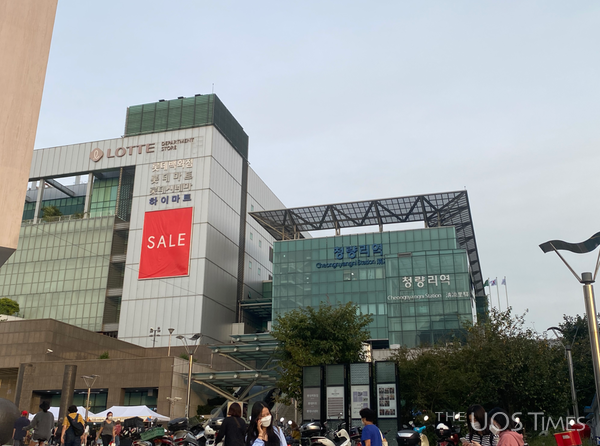Cheongnyangni Station is a special place for students at the University of Seoul (UOS). Most of the students arrive at school via this station, which also serves as a transportation hub in northeastern Seoul. Students going for an excursion to Gapyeong or Daesong-ri usually leave from here. However, Cheongnyangni was not recognized as a pleasant place by Seoul residents. In Korea, there are numerous benefits to living near a metro station. However, before its renovation, the station was treated as a representative slum district in Seoul due to the disordered combination of railways and traditional markets. For students, it is still viewed as an antiquated place that is not very pleasant. However, the neighborhood surrounding Cheongnyangni is becoming modern. High-rise buildings are taking shape. Furthermore, a space was created in front of the station for the younger generation. Let us examine Cheongnyangni's past and present.
Cheongnyangni Station takes its name from an old Buddhist temple. Initially, no construction was planned in this area, but the city officials decided to build the station due to its abundant geographical advantages. In fact, the Cheongnyangni Station expanded significantly during the Japanese colonial period. Japanese railway officials built public offices to reside, but the relics still remain in Jeon-nong dong. Subsequently, the large cargo volume from Seoul Station necessitated the expansion of Cheongnyangni Station by more than ten times in 1935.
Thus, it became one of the busiest stations in the country, second only to Seoul Station. The current station was completed after 12 years of temporary structure. The station, which is currently in use by students and citizens, and which began operation in 2010, attracted investment from several companies. They facilitated the construction of a department store larger than the station adjacent to it. Many students may wonder about the large “Hanwha'' logo on the station’s front side. It is displayed since the entire building was built by Hanwha Station Development. In 2009, shortly before the building was completed, the side name of the station was determined as "University of Seoul."
Cheongnyangni was formerly a red-light district. Owing to the nature of the business, which inherently entails severe violence, the public order of the neighborhood was in shambles. However, as part of a major urban planning project in Seoul, a high-end residential complex will be built. The initial Seoul Master Plan, issued in 1990, called for a “1-main center, 5-subcenter area system, 11-local center system.” However it would be changed to “3-main center, 7-regional center, 12-local center.” Cheongnyangni is one of the seven regional centers and is at the core of Mayor Oh Se-hoon's plan to revitalize redevelopment projects. The Seoul Metropolitan Government simplified the process of private development projects to ensure rapid progress; hence, there have been numerous recent construction projects near Cheongnyangni, with a high possibility that construction will continue until 2023. Meanwhile, voices were raised to document the district’s grim past. The Seoul Metropolitan Government's Urban Reorganization Committee assured that some of them had been restored. However, it was rejected by residents, who banded together to construct a park, for the purpose of development. The construction of new green zones in desolate cities is expected to positively impact students who use stations. This move demonstrates that residents are bringing positive changes to the area.
Additionally, there is a new space for young people in front of Cheongnyangni Station. This place, called "Orang," indicates the gathering of youth. This is the official name of the Seoul Youth Support Center, which provides young people with the resources and information they need. There is a book café on the first floor of the Dongdaemun Orang. On the first and second floors, all users can comfortably read books in a lot of different places. The youth support manager resides in Orang and can be contacted if a user needs assistance in availing of the facilities. Shared kitchens are also available for young people to cook and eat their food. YouTube-accompanied simple recipe programs are also organized from time to time. Additionally, there is a stage where young people can perform. Users are also assigned meeting rooms to get consultations for a start-up business.
The atmosphere of the neighborhood is changing. With the development of Cheongnyangni, eleven large and small markets will leave behind the congested past. They are planning to develop a cultural complex in addition to a new consumer attraction strategy. The most noteworthy aspect is that the residents are involved in the entire process of Cheongnyangni regeneration. Cheongnyangni is changing, and The UOS Times looks forward to the day the brand-new Cheongnyangni and students coexist.






